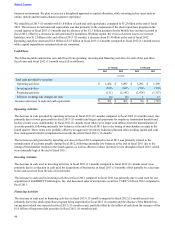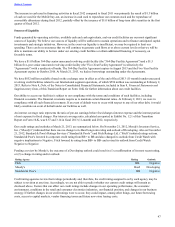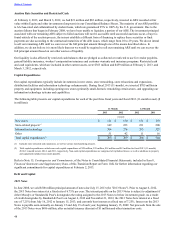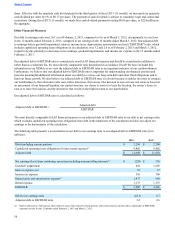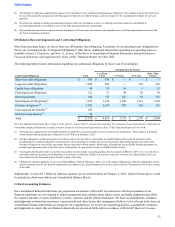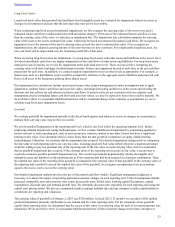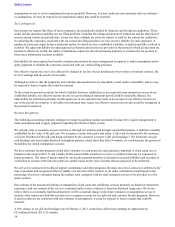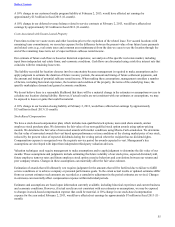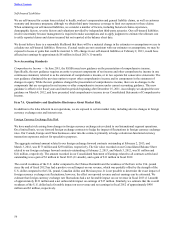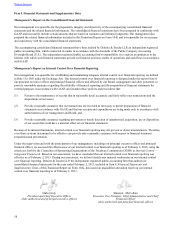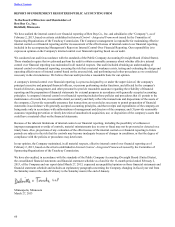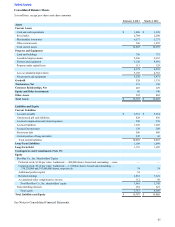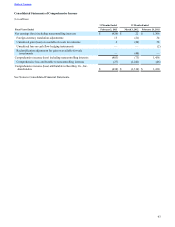Best Buy 2013 Annual Report Download - page 54
Download and view the complete annual report
Please find page 54 of the 2013 Best Buy annual report below. You can navigate through the pages in the report by either clicking on the pages listed below, or by using the keyword search tool below to find specific information within the annual report.
54
assumptions we use to test for impairment losses on goodwill. However, if actual results are not consistent with our estimates
or assumptions, we may be exposed to an impairment charge that could be material.
Tax Contingencies
Our income tax returns, like those of most companies, are periodically audited by domestic and foreign tax authorities. These
audits include questions regarding our tax filing positions, including the timing and amount of deductions and the allocation of
income among various tax jurisdictions. At any one time, multiple tax years are subject to audit by the various tax authorities.
In evaluating the exposures associated with our various tax filing positions, we may record a liability for such exposures. A
number of years may elapse before a particular matter, for which we have established a liability, is audited and fully resolved or
clarified. We adjust our liability for unrecognized tax benefits and income tax provision in the period in which an uncertain tax
position is effectively settled, the statute of limitations expires for the relevant taxing authority to examine the tax position or
when more information becomes available.
Our liability for unrecognized tax benefits contains uncertainties because management is required to make assumptions and to
apply judgment to estimate the exposures associated with our various filing positions.
Our effective income tax rate is also affected by changes in tax law, the tax jurisdiction of new stores or business ventures, the
level of earnings and the results of tax audits.
Although we believe that the judgments and estimates discussed herein are reasonable, actual results could differ, and we may
be exposed to losses or gains that could be material.
To the extent we prevail in matters for which a liability has been established, or are required to pay amounts in excess of our
established liability, our effective income tax rate in a given financial statement period could be materially affected. An
unfavorable tax settlement generally would require use of our cash and may result in an increase in our effective income tax
rate in the period of resolution. A favorable tax settlement may reduce our effective income tax rate and would be recognized in
the period of resolution.
Revenue Recognition
The following accounting estimates relating to revenue recognition contain uncertainty because they require management to
make assumptions and to apply judgment regarding the effects of future events.
We sell gift cards to customers in our retail stores, through our websites and through selected third parties. A liability is initially
established for the value of the gift card. We recognize revenue from gift cards when: (i) the card is redeemed by the customer;
or (ii) the likelihood of the gift card being redeemed by the customer is remote (“gift card breakage”). We determine our gift
card breakage rate based upon historical redemption patterns, which show that after 24 months, we can determine the portion of
the liability for which redemption is remote.
We have customer loyalty programs which allow members to earn points for each purchase completed or when using our co-
branded credit cards in the U.S. and Canada. Points earned enable members to receive a certificate that may be redeemed on
future purchases. The value of points earned by our loyalty program members is included in accrued liabilities and recorded as
a reduction in revenue at the time the points are earned, based on the value of points that are projected to be redeemed.
We sell service contracts for technical support, maintenance and other programs. Revenue on service contracts is deferred at the
time of purchase and recognized either (i) ratably over the term of the contract or (ii) under a utilization model based on the
percentage of services consumed during the contract term compared with the total estimated services to be provided over the
entire contract.
Our estimate of the amount and timing of redemptions of gift cards and certificates is based primarily on historical transaction
experience, and our estimate of the services consumed under service contracts is based on historical usage rates. We do not
believe there is a reasonable likelihood that there will be a material change in the future estimates or assumptions we use to
measure sales returns and doubtful accounts or to recognize revenue for our gift card and customer loyalty programs. However,
if actual results are not consistent with our estimates or assumptions, we may be exposed to losses or gains that could be
material.
A 10% change in our gift card breakage rate at February 2, 2013, would have affected net earnings by approximately
$22 million in fiscal 2013 (11-month).
Table of Contents




